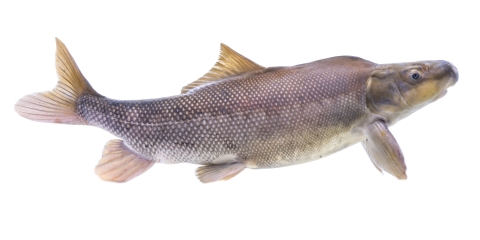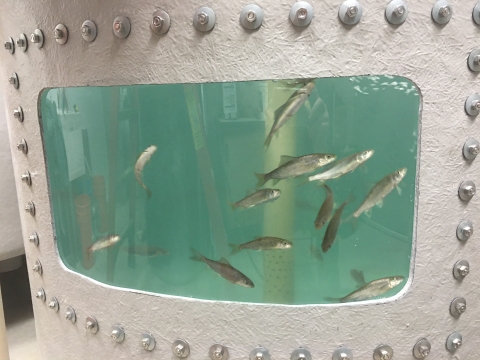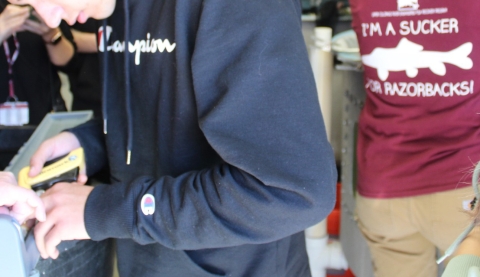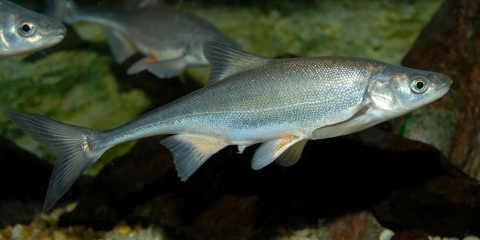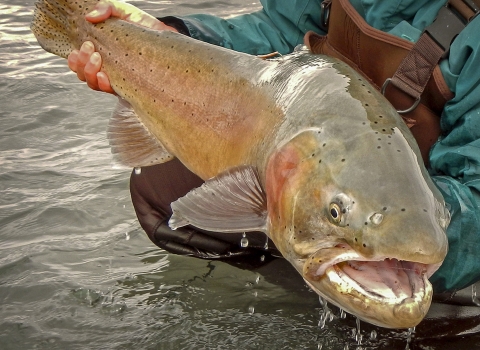High school teacher Pat Steele and student Kiera Stephen sat down with Fish of the Week! podcast co-host Katrina Liebich and guest host Mikaela Oles to talk about raising the Colorado River's endangered Razorback Sucker at the Palisade High School Fish Hatchery and the release of their 1000th fish. Here are excerpts from that conversation. Catch a new episode every Monday!
The native Colorado River fishes look really unique. Can you describe this sucker?
Kiera: They’re pretty big. A Razorback Sucker can grow up to three feet in length. They have a very distinctive keel. It’s made from bone, so it's very hard when you touch it.
Pat: That bony material sits right behind their head and creates a big hump on their back, right behind their head. It’s almost like the keel of a boat. That V on the bottom of a boat cuts through water. The keel on the razorback is just inverted and it does the same thing as the keel of a boat. It helps cut through the water, helps it swim up those raging Colorado River spring runoff waters. And it’s just a beautiful fish. Its brownish top and yellowish belly really helps with camouflage in the murky waters of the Colorado.
When did you first learn about this fish and what inspired you to get involved with its recovery?
Pat: I started teaching a class called River Dynamics. We were doing a lot of field trips out to the Ouray National Fish Hatchery. We really started learning about the fish there and their role in the Colorado River. One day, Mike Gross (who is the fish culturist at that hatchery) mentioned at the end of one of our tours that one of his dreams was to put a fish hatchery at a school. And, basically at that point, I told them that Palisade High School is the perfect place for this. So let's do this! It took us about five years of planning and fundraising. With a lot of help, we were able to repurpose a building and turn it into a cool little fish hatchery.
Can you tell us a little more about how the community came together to help with the project?
Pat: You bet. We were fundraising the heck out of it. It started by word of mouth. We had some key people, like David Miller, who was one of our liaisons in the community. He was like, “Hey, this is what Palisade high school is trying to do.” And over time, like it just kept catching wind.
The next thing you know, we had some people helping us with the planning. We had an architect volunteer time to help us with the drawings and the scale of what we needed to do. We had some construction guys help us figure out what we needed in terms of electricity, insulation and ventilation. We had some parents of students that were really fired up and they started helping us lay out a plan and put together a prospectus. And we were going out with those tools and talking to the community.
Were folks familiar with the Razorback Sucker or did you have to do a little bit of outreach on the why?
Pat: They were definitely not familiar with the fish. A lot of it was, “well, how come you're not raising trout?” Our biggest push at that time was that this fish is an endangered species and how we could help repopulate these fish in the Colorado River.
Our community relies very heavily on agriculture. Of course, without the Colorado River and irrigation systems, we wouldn't have that agriculture. So we have a partnership with our farming community, with our irrigation community, with our wildlife resources community, with those people who use the river for recreation. It's taken a whole group of people to help these fish come back from where they were in the mid-nineties to where they are now. And we've been able to bridge differences: this is something that we value as a community and we are educating our future farmers and irrigation folks and ecologists and recreationalists about.
If we were to come to your school and tour the hatchery, what would we see?
Kiera: Our hatchery sits behind our track and football field. It used to be an old astronomy shed that stored telescopes and astronomy equipment. We still have a little bit of astronomy stuff in the corner, but now we have three 250-gallon rearing tanks, all lined up on the right wall. Straight back into the left is where we keep our filtration system. We have a fully integrated filtration system with two bag filters.
We got a vortex filter over this past summer, which was an incredible improvement for our system. and then we have a big black tank sitting in the middle of the hatchery, that we use to store water, and we have, a little room on the left as you walk in where we keep our food and, a little refrigerator to keep our food in and our hatchery equipment, materials, water pumps, chemicals, all the fun stuff.
How do you get your fish?
Kiera: Usually, in the fall, we get fish from the Ouray National Fish Hatchery Grand Valley Unit, but this year was really special because last spring, our team got the opportunity to go and help spawn this batch of fish. When school got back in session and we got our hatchery up and running again, we were able to receive those fish as little fry. They're probably about an inch at that time. They're silver, and don't have their razor yet.
How many students are working there and what's the distribution of duties?
Kiera: Currently, we have three consistent people: me, my co-worker, Kale, and a newer member, Ashley. We go down every single morning and do daily tasks that include feeding and siphoning the tanks. We scrub the tanks and do water changes three times a week. We take the water that we have sitting in the big black tank that's about 300 gallons, and simultaneously empty water from our system and refill it.
Pat: Thing about our system is that it runs on tap water. It's a recirculating system, and in order for us to run it on tap water two things have to happen. One, that water has to be the same temperature as the ambient air. That's how we heat and cool our water in the hatchery is through the ambient air. So we let it sit a couple of days to get up to temperature and then we also let it sit a couple of days to get the chlorine out before we add it into our system.
And how many fish do you currently have?
Kiera: Usually around 250ish, but currently we have around three hundred.
What's your favorite part about working for the Hatchery, and has anything surprised you?
Kiera: That’s a really tough question. Just being involved in this incredible opportunity and the conservation and recovery efforts of these fish. And also the team members that I work with. I really enjoy the technical aspects of it, which was surprising. When I first joined the hatchery, I was in it for the fish. And as much as I love fish, I have found myself extremely fascinated by the system and all of the things that make a hatchery function.
What are some of the ways you've seen this project make a positive impact on the students that you work with?
Pat: We're very excited to have our hatchery technicians like Kiera and Kale and Ashley right now. They're the ones that kind of run the show. It's awesome that we can take something like that and turn it over to young people and let them take it over, right?
Our whole goal was to make it as much a student-led and -run program as we could.With students like Kiera and Kale, they make it happen. They could run the hatchery on their own and don’t necessarily need me at this point. They know what they're doing, and are so observant. Every morning they observe the fish: How are they acting? How are they behaving? Are they eating all their food? Is there a lot of leftover food? How much waste is there? And how are they schooling up? I feel like I'm just kind of the facilitator or the problem solver if need be, but usually they've already got it figured out and they've just let me know, “hey, this is what we did. This is what was going on.”
And then we have my classes that are involved in not so much the daily work of the putting in the elbow grease, but more of like where we are really looking at the water chemistry. We're studying how it changes through the week. Every three to four weeks, we weigh all the fish in each tank and then do some calculations to figure out how we need to adjust feed.
Our hatchery project is an educational system. That's our whole goal, right? We basically treat our hatchery like a living lab. We have students that set up different experiments. For instance, Kira did a feed analysis study. We were having some problems, so we changed feeds. And she was tracking how those feeds helped with growth rates.
We've had students look at changing the amount of light in the hatchery to model what we see naturally to see if that impacted rate of gains. We've had students look at indoor rearing of fish versus outdoor rearing and where they compared our growth data to an of an indoor system to system getting data from like the Willow Beach Hatchery in Arizona, where that grow their fish in outdoor ponds throughout the year. If there are other ideas that students have, we definitely try to make those happen.
What are some of your favorite observations you’ve made about the educational growth of your students?
Pat: We're not just growing a sportfish, you know? A lot of our students are avid fishermen, me included. We spend a lot of time talking about their importance in the ecosystem and what would happen if they weren't in the ecosystem. And then, the fact that our students start growing an appreciation for sucker fish, instead of just thinking of them as a bottom feeder or trash fish, they start looking at them like, “man, these fish really are cool!”
And then Kiera and Kale and the technicians are the professionals that help train my students. When we do PIT tagging, every one of my students gets an opportunity to insert a few PIT tags and Kiera and Kale are the ones teaching those kids how to do that. That’s one of my favorite days. I'm sitting back watching them take over and run the show.
My other favorite is just seeing how excited students get about these fish. Most of my students have never even touched a fish. We have several fish that have special names, whether it's their size or they're missing, a fin. They've studied these fish so much that they've named several of them. And so that's fun to introduce those named fish to our classes and they get an opportunity to get to know those fish too.
And then the best part of the whole thing is the release day and those kids...our whole school feels like it goes down to the river and, and all of them have an opportunity to put a fish into the river. When all of our students get an opportunity to release fish, I feel like they really have that connection to the river. Our hope is that, as they become adults, they remember that they helped with that, and they were a big part of that repopulation of those fish. And that they know the importance of taking care of that river as they get into their adult age.
Man, there's so much there. You've got math, some engineering with the different systems, scientific observations. That's a really neat, applied, hands-on classroom you've created. Kudos on that!
Pat: Thank you.
What are the exciting things that happen on release day? I know you're reaching a really big milestone.
Kiera: Yeah, so this year we'll mark our 1000th fish released. Over the course of the past few years, we've been releasing 250 fish a year. We will also have a very special guest, Jeff Corwin. I'm really excited about that.
When you send the fish off, I'd be curious – a couple of the fish that you've named, what their names are, and if you have any special hopes for them, or if you're going to miss them, or feel kind of torn between sad and happy that they're leaving?
Kiera: Every year we have at least one Timmy and one Jimmy. Usually our Timmies and Jimmies are the smallest ones. This year we have a fish named Walter, who I'm really excited to release. He’s our biggest fish by far. He's a large fish. I'm excited to see Walter off into his journey through the Colorado River.
On release day, it's a very special feeling. I wouldn't say it's sad, or happy really. It’s very cathartic. I've been down there every single morning with these fish and watching them grow from, little baby fry all the way to where they are now. But seeing them, be released into the river is a unique feeling and I'm excited to be a part of such an amazing project. Seeing them go is, while it's a little bit sad because, you know, they're like my little babies, it's very rewarding.
How do you actually get your fish down to the river?
Kiera: We have a truck and trailer. And the river is right out our back door. We temper the water so that it's close to the temperature of the river, and then we just haul them over to the boat ramp.
Pat: The other cool part about our release is that a lot of hatcheries just open the floodgate so to speak, and send those fish through a tube, all at once. We feel like there's a lot better connection if we release one fish at a time. It incorporates so many more students and it makes it a lot more fun, a lot more intimate, and just create that connection with those fish. It really is a fun event. We have this tradition of, before you release that fish into the river, you have to kiss it goodbye. They really get a firsthand look on how good those sucker lips are for that process.
How, how big are the fish when you're releasing them?
Kiera: They range anywhere from three to six, sometimes even seven inches.
Okay, so pretty big. How big is Walter?
Kiera: Pretty decent size. Walter's probably like seven inches, six and a half.
Dang, Walter.
Kiera: Yeah. he's a big fish.
Pat: By the time we release them, some fish are pushing 10 to 12 inches long.
And that's probably given them a really big "fin up" in terms of just some of the dangers they face in the river, taking out all that mortality that they'd experienced in the wild. You're doing a great job giving them a good start.
Pat: Yeah, that's our goal for sure. Get them as big as we can, as fast as we can.
You mentioned PIT tags, and for folks who aren't familiar, they’re about the size of a grain of rice, and you insert them into the fish. Are you tracking the fish from year to year?
Pat: Yes. Those PIT tags are key ingredients for us to see how our fish are faring out in the wild. Each summer, as the fish biologists start floating the Colorado River and doing their population collections and things like that, those PIT tags get put onto a website/spreadsheet for us. Some data analysis folks have created some pretty cool maps for us where they've been able to upload the different encounters with our fish through the last three summers.
We know they're out there, which is awesome. It's a great feeling to see some of them from our very first batch that we released in 2020. They are of spawning age now and could be spawning. That's one of the unique things, and also one of the problems with Razorback Suckers, is that they don't reach a reproduction maturity until they're three or four years old. And because that takes so long, they got to survive that long to be able to then reproduce. But finding some of our fish that are three to four years old now, hanging out in those big spawning grounds, it's pretty exciting. We hope that we start seeing some wild fish be born from our fish raised at Palisade High School.
That's amazing. I hope Walter and Timmy and Jimmy do well and you're able to track them through time. What would you like to say to other students around the country about caring about your rivers and fish?
Pat: Our hatchery is 11 by 14 feet. It's not very big. What we've learned is: if you have a small space, that doesn’t mean you can't create something cool like this. And we run our hatchery on tap water. Every school has tap water, and every school has probably a small space they could repurpose and turn into something cool like this in terms of rearing fish. We're figuring out that you don't have to be nearby an ocean. You don't have to be even nearby any true water resource. We're fortunate that we have the Colorado River out our back door, but if you are able to create some local partnerships and you're able to truck your fish to a water resource, any school can do what we're doing.
Kiera: If I'm being completely honest, when I started here at Palisade, I had no clue what a Razorback Sucker was. I didn't even know that I wanted to go into a career in biology. But, through my involvement with the hatchery, I've learned an incredible amount about these fish. I've learned about the impact that an individual can have on the ecosystem, and I've gained an incredible understanding of the role that every individual species plays.
Anything to add about this partnership or the recovery of razorback suckers?
Mikaela: I can say without a doubt that working with Palisade High School, Pat, the students, the partners, it's definitely my favorite thing to help with every single year. It has all of the components for success. It's got adults who are empowering future generations and communities with differing opinions coming together for a common goal.
The students are really passionate, and they want to learn and it's really cool just to see, how many partners come together to support this whole project, including the Upper Colorado River Endangered Fish Recovery Program. It has a bunch of different partners that are just trying to protect the Colorado River and its fishes.
And also, the Colorado River is just really awesome, and the Razorback Sucker is a super cool fish. And I think you could tell from our conversation today that the future of conservation is in super good hands.
Anything we missed that you'd like to add?
Pat: This project and this ability to incorporate fish hatcheries that are raising endangered species. It's starting to catch on. We're hoping that there's a school in Vernal, Utah working right now to incorporate a fish hatchery of their own, to be able to raise Razorback Suckers as well and help with the population within the Green River. A school in Las Vegas, Nevada has started up a little fish hatchery raising Bonytail Chubs.
So, it's starting to catch on. The possibilities of these being at a lot of inland schools that aren't necessarily near big bodies of water, it's pretty cool to see those starting to pop up we hope that we can help do that and help those schools implement these types of programs.
Do you have any other fish you'd ever like to raise in your hatchery or any plans for future growth?
Pat: Yeah, we always have big plans. It's just trying to find the time and the money to do it all. Of course, we would love to expand it and make it a lot bigger to be able to just hold more students when we're in there together. I’d love to be able to create a classroom and lab right next to it. We've talked about even being able to build like a small greenhouse where we could take our wastewater and turn it into an aquaponics system.
If we ever get the opportunity to help grow Colorado Pikeminnow that would be cool. The students are always enamored by the sheer size (6 feet!) that those can reach and the fact that they're one of the largest predators in the Colorado River and they don't have teeth.
All of our endangered species in Colorado River are so unique that any of them would be fun. And, the speed of the Bonytail Chub and how fast they zoom through the water would be really cool to see firsthand every day. And then the Humpback Chub, of course, being able to see the unique features and how they differ between the Razorback, even though they have that similar kind of hump on their back. I would take any of them. But we're just still focused on that goal to help the Razorback Sucker.
This is such a great example of how everyone can make a difference for fish, whether you're a kid or an adult or, inland or on the sea. there's a role for everybody and just really great work to you two and kudos to all the students and that entire team involved with this project. Get out there and live with, live from, discover, and enjoy #AllTheFish!
Catch all the episodes about the Colorado River's native fishes:
We honor, thank, and celebrate the whole community — individuals, Tribes, States, our sister agencies, fish enthusiasts, scientists, and others — who have elevated our understanding and love, as people and professionals, of all the fish. In Alaska we are shared stewards of world renowned natural resources and our nation’s last true wild places. Our hope is that each generation has the opportunity to live with, live from, discover and enjoy the wildness of this awe-inspiring land and the people who love and depend on it.


